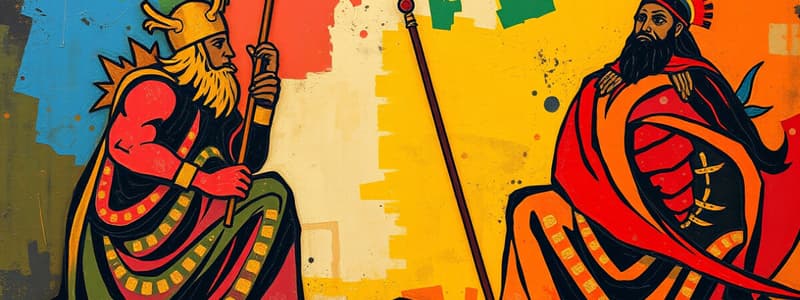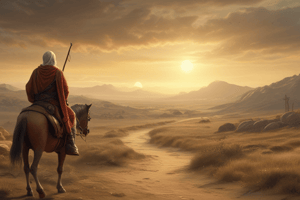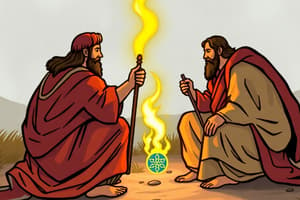Podcast
Questions and Answers
What did the two historical books of Judges and Ruth cover?
What did the two historical books of Judges and Ruth cover?
Life in God's land would be difficult if the people persisted in their sin.
The Book of Judges is part of what larger literary unit?
The Book of Judges is part of what larger literary unit?
The books of Samuel and Kings detailing the history of God's people.
What kind of composition was the Book of Judges?
What kind of composition was the Book of Judges?
An anonymous composition.
What kind of history is the Book of Judges a part of?
What kind of history is the Book of Judges a part of?
Who were the judges in the Book of Judges?
Who were the judges in the Book of Judges?
Did any of the judges establish a royal dynasty?
Did any of the judges establish a royal dynasty?
What is the center of the Book of Judges about?
What is the center of the Book of Judges about?
When did the judges rule Israel?
When did the judges rule Israel?
What is also attached to the center of the Book of Judges?
What is also attached to the center of the Book of Judges?
What did the introduction and 2 appendixes talk about?
What did the introduction and 2 appendixes talk about?
What phrase in the introduction of the Book of Judges has an important historical and theological function?
What phrase in the introduction of the Book of Judges has an important historical and theological function?
Why is the phrase 'After the death of Joshua' important?
Why is the phrase 'After the death of Joshua' important?
The period of the judges is a time of what?
The period of the judges is a time of what?
What is significant about the introduction in the Book of Judges?
What is significant about the introduction in the Book of Judges?
How does the introduction in the Book of Judges supplement the Book of Joshua?
How does the introduction in the Book of Judges supplement the Book of Joshua?
What does Judges describe?
What does Judges describe?
What does the Book of Judges inform us about?
What does the Book of Judges inform us about?
What does the concluding paragraph of this unit confirm?
What does the concluding paragraph of this unit confirm?
Why did Israel fail to complete the conquest?
Why did Israel fail to complete the conquest?
What does the central part of the Book of Judges demonstrate?
What does the central part of the Book of Judges demonstrate?
What does the introduction in the central section of the Book of Judges introduce?
What does the introduction in the central section of the Book of Judges introduce?
Match the following judges with their descriptions:
Match the following judges with their descriptions:
What do the six judges illustrate about God?
What do the six judges illustrate about God?
What two judges were worthy of emulation?
What two judges were worthy of emulation?
The cycle shown in the central unit of the Book of Judges includes: ___, war as judgement, repentance, and deliverance.
The cycle shown in the central unit of the Book of Judges includes: ___, war as judgement, repentance, and deliverance.
Who were the six judges?
Who were the six judges?
Flashcards are hidden until you start studying
Study Notes
Overview of Judges and Ruth
- Judges and Ruth depict life in God's land amid challenges due to persistent sin.
Literary Context
- The Book of Judges is part of a larger unit with the books of Samuel and Kings, chronicling the history of God's people.
Authorship and Composition
- Judges is an anonymous composition, contributing to the Deuteronomistic History.
Role of Judges
- Judges served as charismatic military leaders, chosen by God to fulfill specific deliverance tasks.
- The twelve judges acted as local or national heroes, leading Israel to victory over enemy nations.
Dynastic Structures
- No royal dynasty was established by any of the judges listed in the Book of Judges.
Structure of the Book
- The central part consists of stories about the judges and their leadership era, spanning from Joshua's death to Samuel's rise.
- Additional sections include an introduction and two appendixes discussing episodes unrelated to individual judges.
Key Historical Marker
- The phrase "After the death of Joshua" is crucial for understanding the transition from a successful era under Joshua to a new chapter in Israel's history.
Themes of Disobedience
- The period of judges is characterized by Israel’s disobedience and failure.
- The introduction supplements Joshua by detailing the conquest’s nature and the incomplete military victories of individual tribes.
Israel's Cultural Context
- Israelites coexisted with Canaanites, leading to cultural and religious influences that swayed Israel's faith practices.
Cycle of Disobedience
- The concluding paragraph emphasizes Israel’s recurrent disobedience and failure to complete the conquest due to lack of faith.
Repeated Historical Cycle
- The central part illustrates a historical cycle: Israel sins, faces judgment through enemy nations, repents, and God raises up judges, but lapses back into sin after the judge's death.
- This cycle recurs with six judges—each time reaffirming the pattern of sin, judgment, repentance, and deliverance.
Notable Judges
- Six judges are highlighted: Othniel, Ehud, Deborah, Gideon, Jephthah, and Samson.
- God’s grace and mercy are shown through these judges, rather than consistent devotion to Him.
Exemplary Figures
- Othniel and Deborah are recognized as worthy of emulation for their leadership and faithfulness.
Studying That Suits You
Use AI to generate personalized quizzes and flashcards to suit your learning preferences.




